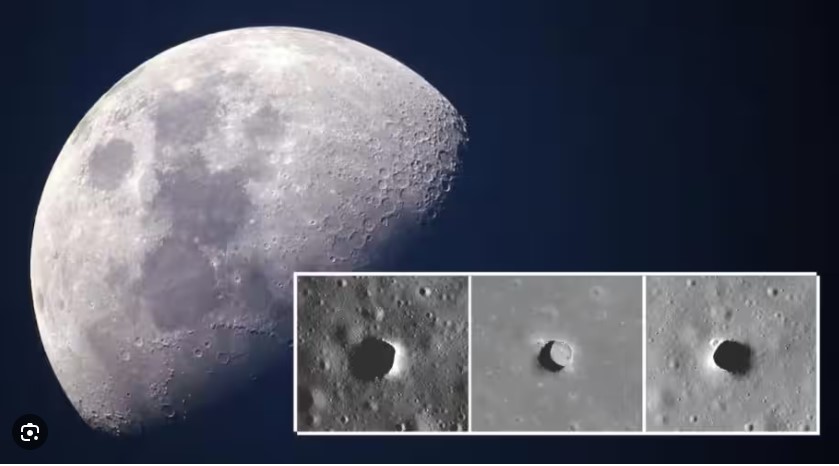The Moon, Earth’s constant companion, has been a subject of intrigue and study for centuries. Recently, the discovery of a massive cave spanning 50 kilometers in length has added a new dimension to lunar exploration. This article delves into the significance of this discovery, the potential scientific breakthroughs it holds, and the future of lunar research.

## The Discovery: A Lunar Marvel
### Uncovering the Cave
The discovery of the 50 km long cave on the Moon was made possible by advanced lunar orbiters equipped with high-resolution imaging and radar technology. These orbiters, including Japan’s Kaguya and NASA’s Lunar Reconnaissance Orbiter (LRO), have been mapping the Moon’s surface in unprecedented detail. The cave, located in the Marius Hills region, was identified through a combination of surface imagery and radar data, which revealed a vast underground cavity.

### Geological Significance
The Marius Hills region is known for its volcanic domes and extensive lava tubes. The newly discovered cave is believed to be a colossal lava tube, formed billions of years ago during the Moon’s volcanic period. These lava tubes are created when a channel of molten lava flows beneath the surface, eventually draining away and leaving behind a hollow tunnel.
## Potential Benefits of the Lunar Cave
### A Safe Haven for Astronauts

One of the most exciting prospects of this discovery is the potential use of the cave as a habitat for astronauts. The Moon’s surface is a harsh environment, with extreme temperatures, high levels of radiation, and frequent micrometeorite impacts. A cave could provide natural shielding from these hazards, making it an ideal location for a lunar base.
### Scientific Research Opportunities
The cave offers a unique opportunity for scientific research. Its untouched interior could hold clues about the Moon’s geological history and the processes that shaped its formation. By studying the cave’s structure, composition, and any potential ice deposits, scientists can gain insights into the Moon’s volcanic activity and the presence of water ice, which is crucial for future lunar missions.
### Resource Utilization
In-situ resource utilization (ISRU) is a key concept for sustainable space exploration. The cave could potentially contain valuable resources such as water ice, which can be used for drinking water, oxygen production, and fuel for rockets. Utilizing these resources would reduce the need for costly resupply missions from Earth and make long-term lunar exploration more feasible.
## Challenges and Future Exploration
### Accessing the Cave
One of the primary challenges is developing the technology to safely access and explore the cave. Rovers and robotic explorers will need to be designed to navigate the cave’s interior, mapping its layout and identifying areas of interest. Advanced robotics and autonomous systems will play a crucial role in these initial exploration efforts.
### Human Exploration
Eventually, the goal is to send astronauts into the cave. This will require the development of new space suits and life support systems capable of operating in the unique environment of a lunar cave. Additionally, the construction of a lunar base within the cave will necessitate innovative engineering solutions to provide a stable and habitable environment.
### International Collaboration
The discovery of the 50 km long cave presents an opportunity for international collaboration in lunar exploration. By pooling resources, expertise, and technology, space agencies around the world can work together to unlock the cave’s secrets and pave the way for future missions. Collaborative efforts will also help distribute the costs and risks associated with such ambitious projects.
## The Broader Implications
### Inspiring Future Generations
The discovery of the lunar cave and the subsequent exploration efforts will undoubtedly capture the imagination of people around the world. It serves as a reminder of humanity’s innate curiosity and drive to explore the unknown. This discovery will inspire future generations of scientists, engineers, and explorers to pursue careers in space exploration and contribute to our understanding of the universe.
### Advancing Space Exploration
Exploring the lunar cave will provide valuable experience and knowledge that can be applied to future missions to other celestial bodies. Techniques and technologies developed for the Moon could be adapted for use on Mars, asteroids, and beyond. The lessons learned from this endeavor will help pave the way for humanity’s journey deeper into space.
## A New Frontier on the Moon
The discovery of a 50 km long cave on the Moon marks a significant milestone in lunar exploration. This natural wonder offers immense potential for scientific research, resource utilization, and the establishment of a human presence on the Moon. While challenges remain, the international space community is poised to tackle these obstacles and unlock the secrets of this lunar enigma. As we stand on the brink of a new era in space exploration, the lunar cave beckons us to venture into its depths and continue our quest to explore the final frontier.

